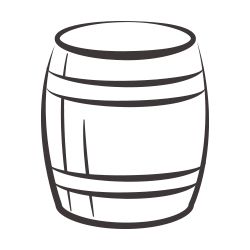A red wine from heroic seaside viticulture
FAVINIA LE SCIABICHE
IGT Terre Siciliane
Perricone and Nero d’Avola
In the Calamoni Estate, the excellence of the native vine varieties of Nero d’Avola and Perricone is enhanced with the sensory properties of grapes ripened in an extreme environment in terms of its climate conditions and vicinity to the sea. Favinia Le Sciabiche is the gift resulting from the constant synergic action of the sea, wind and earth. It is the result of the great care Firriato extends to Sicilian land. The soil of the Calamoni Estate is rich in marine fossils and fish skeletons which have sedimented over the course of millennia. The extraordinary features of the terroir, in which Quaternary bio-calcarenite limestone plays a fundamental role, gives the wine an intense pleasantly saline note which together with the elegant aromas of Mediterranean scrub make for an outstandingly unique red wine, comparable to a great Pinot Noir.
- Appellation: IGT Terre Siciliane
- Vine: Perricone and Nero d’Avola
- Terroir: Favignana island- Calamoni di Favignana
- Soil: Quaternary bio-limestone with high presence of marine fossils
- Exposure: south (0 mt. a.s.l)
Production Area
Calamoni di Favignana

The Calamoni Estate lies on the central southern slope of the island, just a stone’s throw from the sea, on the narrowest part of this area of land facing the Marsala coast. The vineyard stretches over more than 5 hectares, enclosed by traditional dry stone walls.

Favinia le Sciabiche
The Egadi Islands Red
Nero d’Avola and Perricone are two symbols of Sicilian oenology. The first is widespread across the whole of Sicily and is well-known on an international level. Perricone, on the other hand, is a variety which risked sinking into oblivion, but which has been recovered and enhanced by Firriato. These are the two native red grape varieties which go to make Favinia Le Sciabiche. Planting these two vines in a seaside terroir was the start of a challenge Firriato wanted to undertake to test the plants’ adaptability to soil and climate conditions differing from those of the Trapani agricultural area. The results have been surprising and sometimes unpredictable. A glaring example is the ripening time of Nero d’Avola and Syrah on Favignana. Unlike the estates in the Trapani agricultural area, where these grapes have different harvest times, on the island of Favignana these grapes ripen and are harvested at the same time.
Favinia le Sciabiche
The Marine Influence
Favinia La Sciabiche is the red label coming from the unique vineyard of the Egadi archipelago where red grapes of the native Sicilian ampelographic heritage grow: Nero d’Avola e Perricone. The grapes are grown at sea level, the shore lying just 10 metres from the vineyard. The particular pedoclimatic context influenced by sea proximity characterizes the sensorial profile of this wine , releasing briny notes in the glass. Winds work like a “marine nebulizer” by spreading nebulized sea water in the vineyards that contributes to influence the aromatic profiles of grapes.


Favinia le Sciabiche
The Sea Viticulture
Viticulture practiced on small Islands is an inconceivable challenge under an effort point of view. Firriato understood the great value of Favignana’s land. Emerged lands of close geological epochs and soils riched in marine fossils represent the viticultural scenario where Firriato, for the first time in the history of Favignana, has introduced a viticulture destined to high quality wine production.
At the beginning of this agronomic challenge there was no scientific literature adivised about what vine varietal was supposed to be planted or any certainty relating possible results after vinification. An experimental viticulture impossible to find everywhere.
FAVINIA LE SCIABICHE
The characteristics of vintages
2018
During the year 2018 in Trapani, frequent rainfall occurred, followed by an attenuation towards the final stage of grape growth. Temperatures, relatively cooler than the previous year, showed notable thermal fluctuations between day and night, creating ideal conditions for the ripening of red grapes.
2015
An average higher quality yield compared to 2014 makes the island of Favignana rejoice, which after some worries at the beginning of the winter, was able to enjoy a particularly favorable climatic trend in spring and summer.
2013
The year showed to be fruitful. Either regarding the quantity, and definitely regarding the quality “very interesting wines regarding the aromatic profile” had been obtained. Because of the climate, the harvest lasted till the last week of September. The year 2013 gave a slower harvest and then a gradual maturation.
2012
The vintage looks fruitful, both in quantity and especially in quality were obtained “wines interesting profile”. Because of the climate gathering lasted until the last week of September. The year 2013 has enabled a collection slower and then a gradual maturity: the harvest was delayed by two weeks.
2011
The middle third of September marked the start of the harvest on the island of Favignana, a terroir that Firriato was able to exploit to its full potential thanks to its heroic vocation and the orographic features of the land that enable large amounts of healthy grapes to grow and ripen. The 2012 vintage was marked by an average climate, with high temperatures during the summer months, which accelerated the fruit ripening process.


FAVINIA LE SCIABICHE
Awards
2013
Luigi Veronelli: 3 Stars
2012
Bibenda: 4 Red clusters
2011
Luigi Veronelli: Great Beginning
Paired with
Roasted Rack of Lamb
Preheat oven to 450 degrees F (230 degrees C). Move oven rack to the center position. In a large bowl, combine bread crumbs, garlic, rosemary, 1 teaspoon salt and 1/4 teaspoon pepper. Toss in 2 tablespoons olive oil to moisten mixture. Set aside.


















